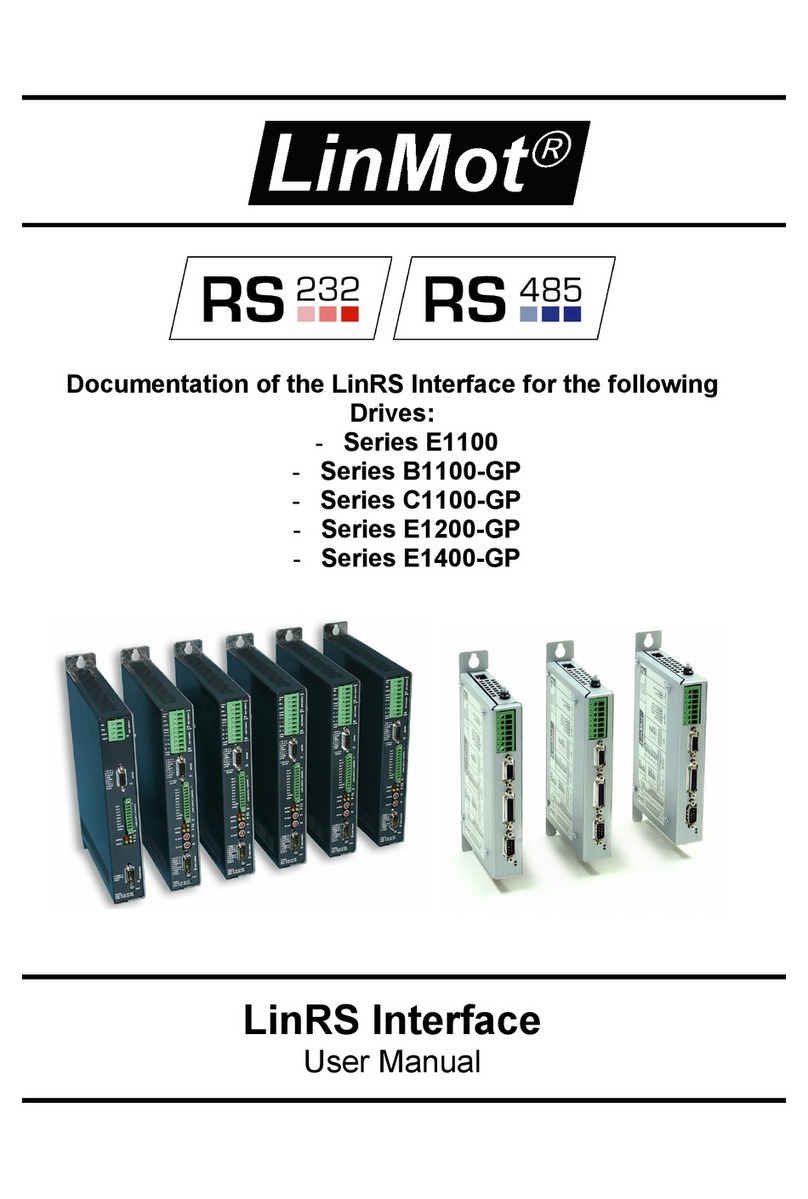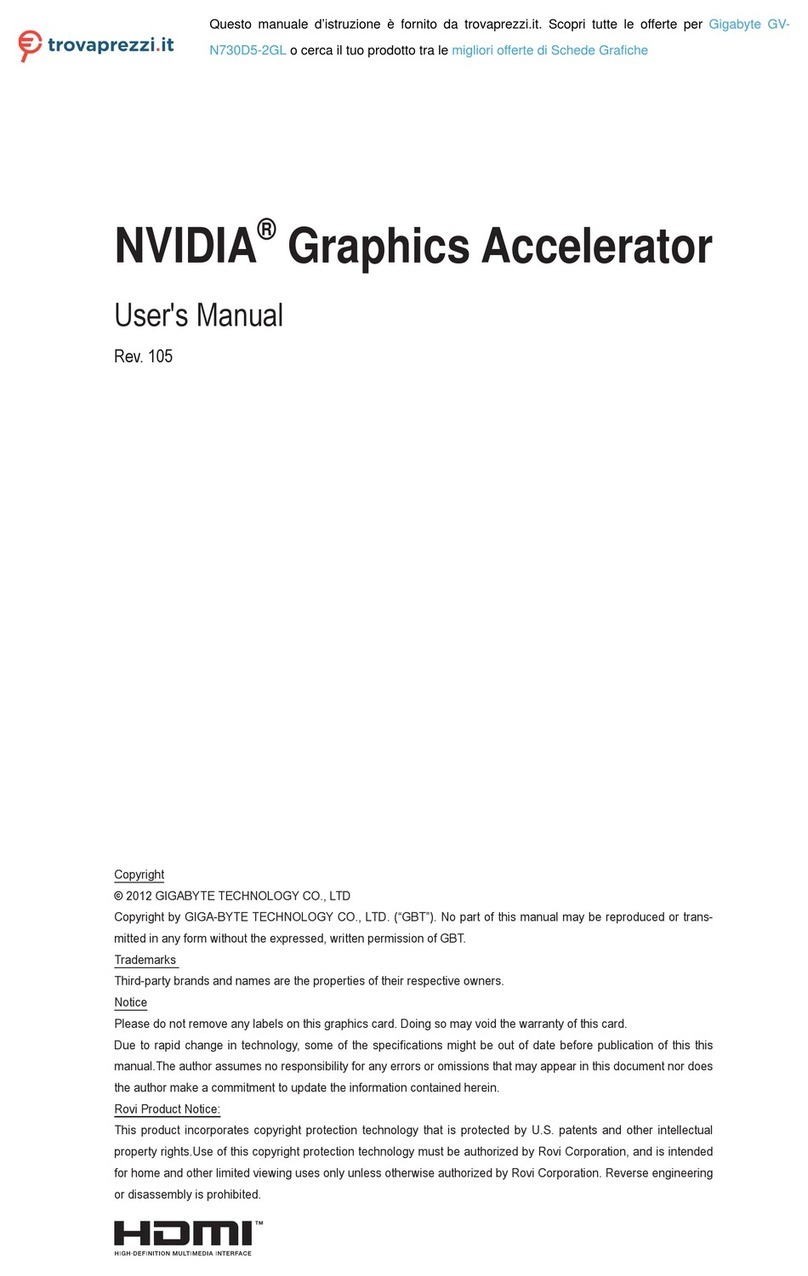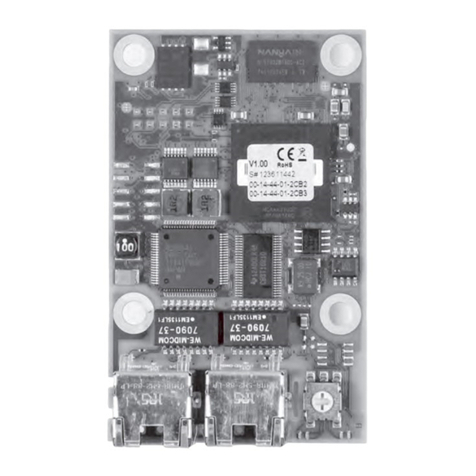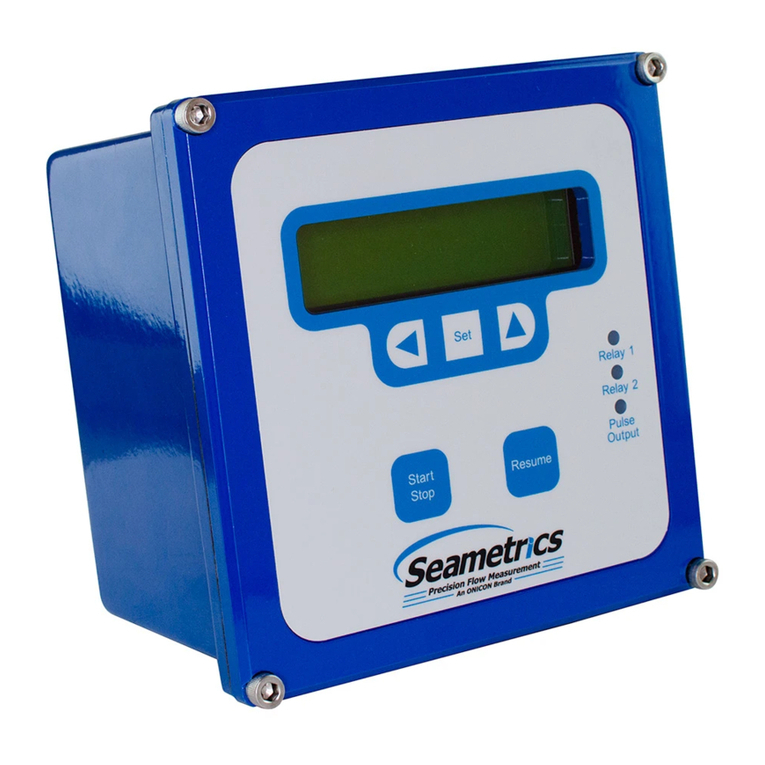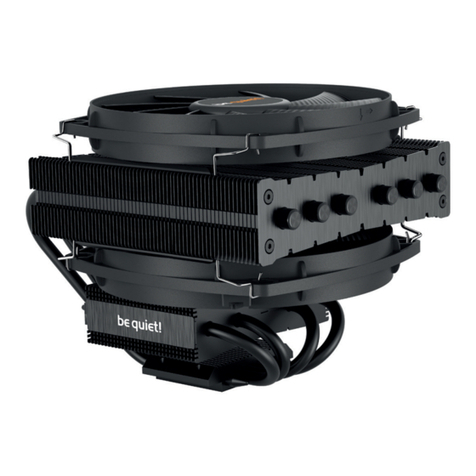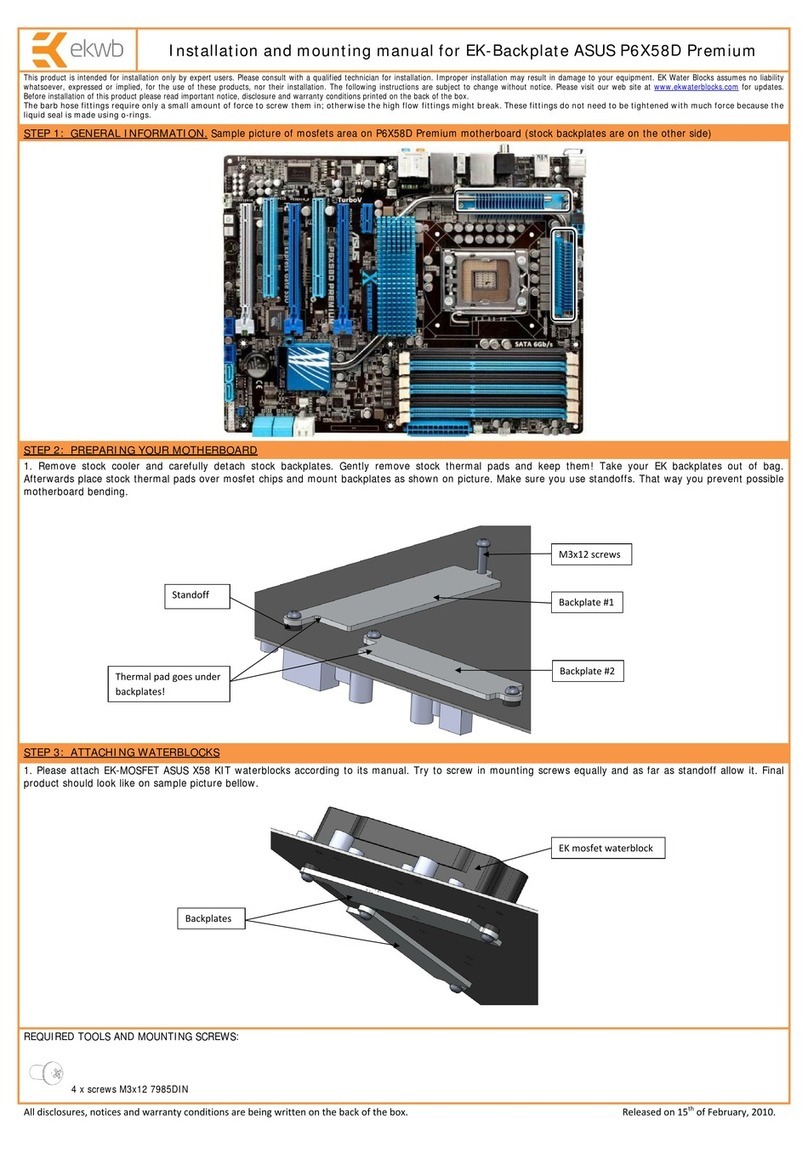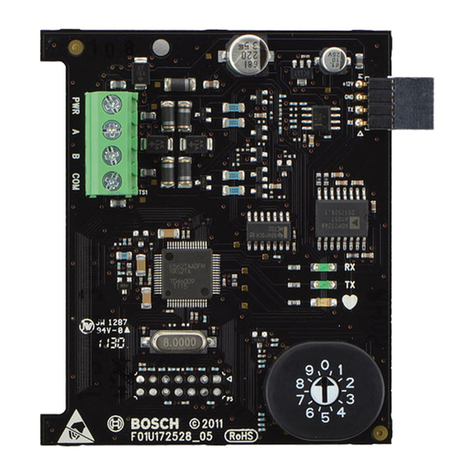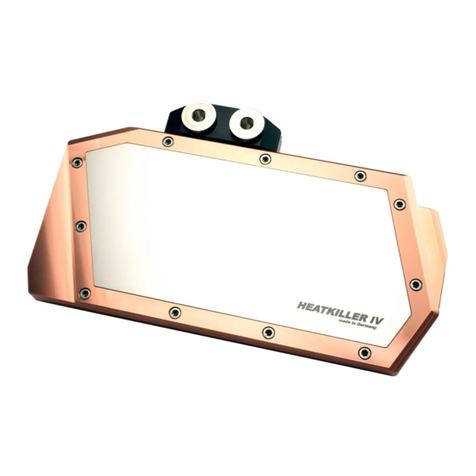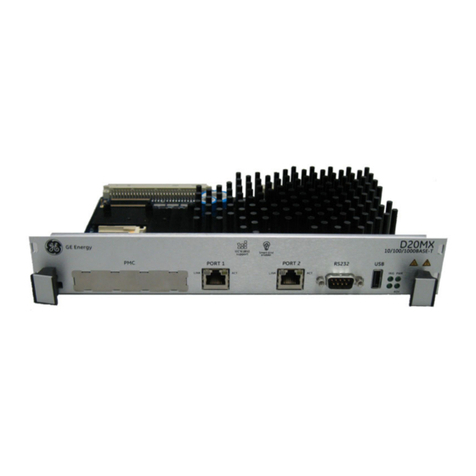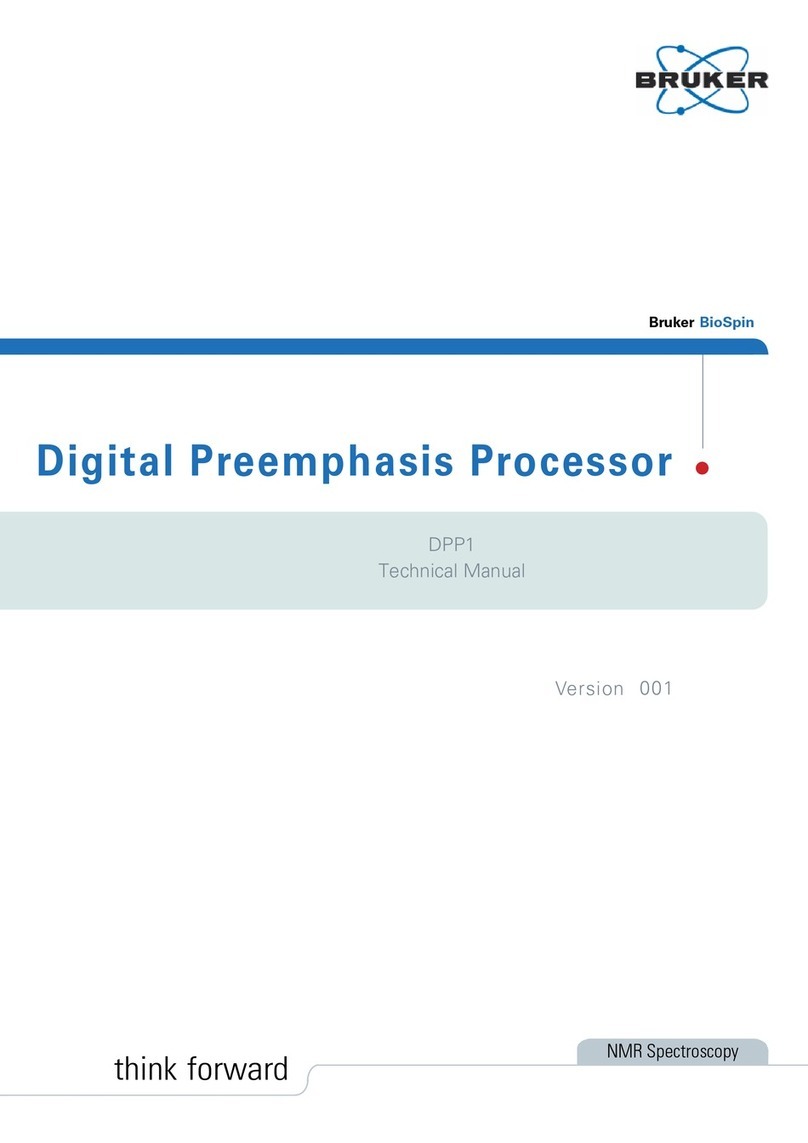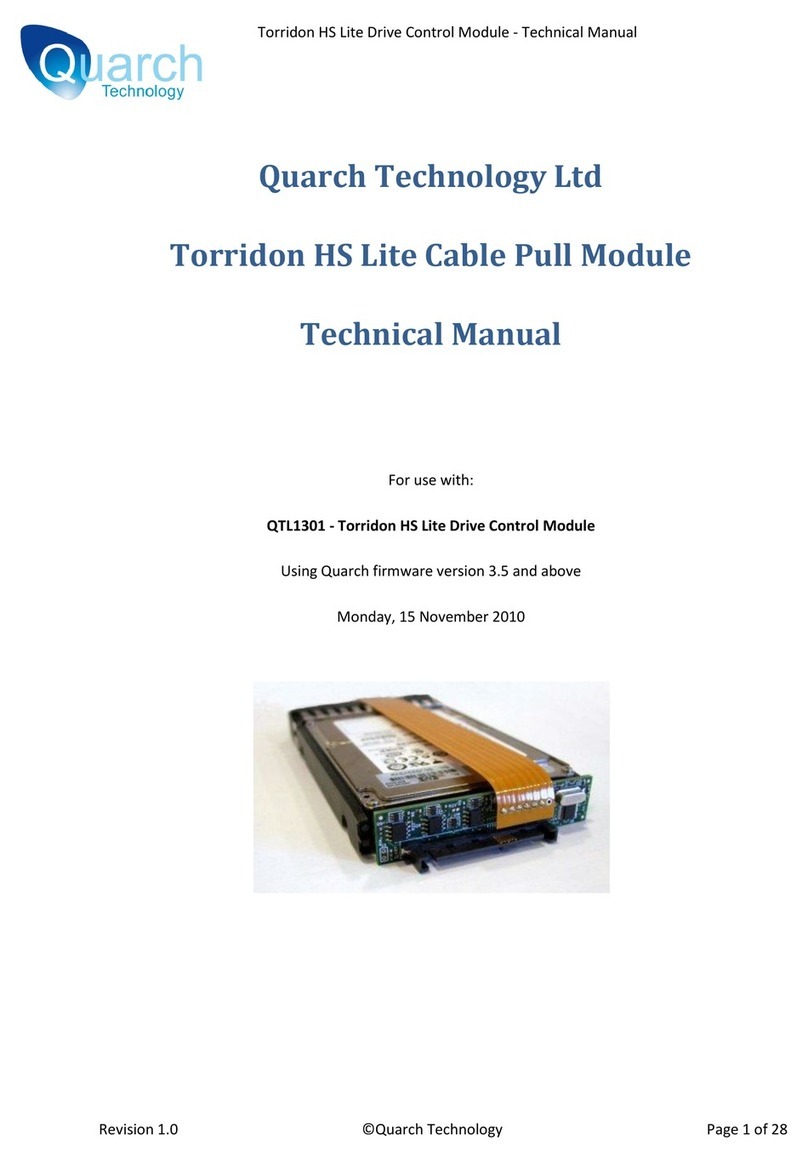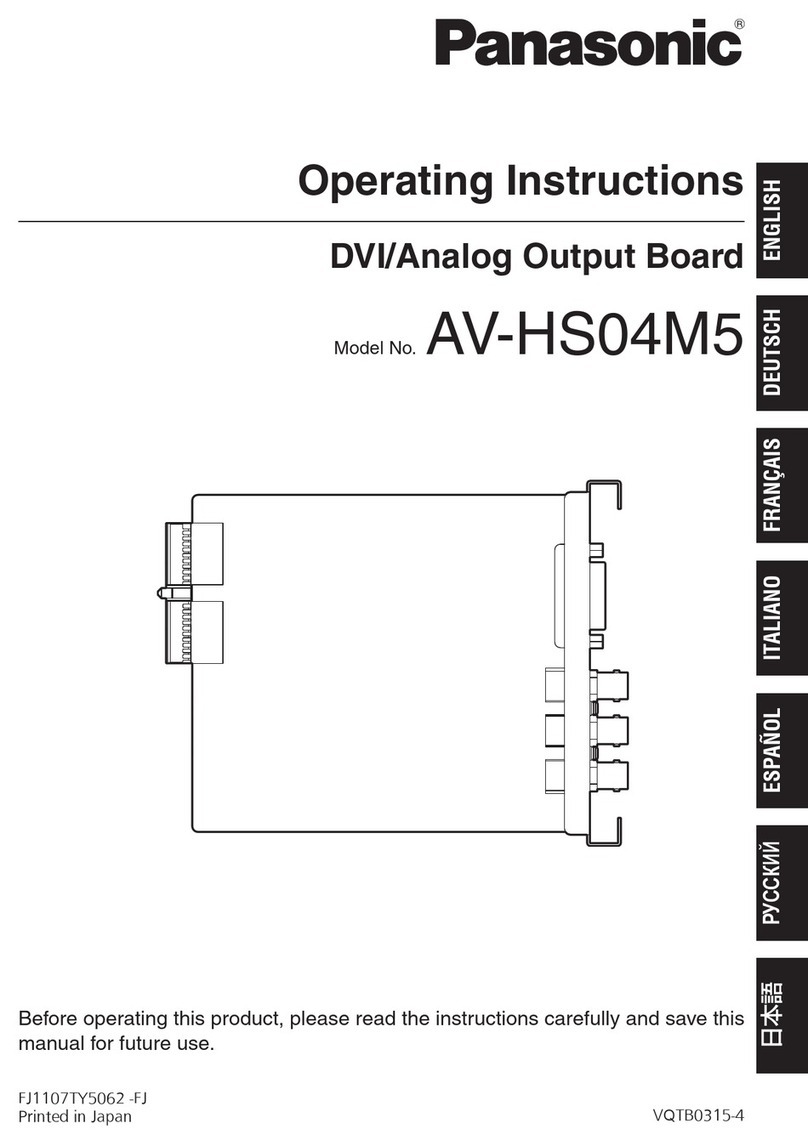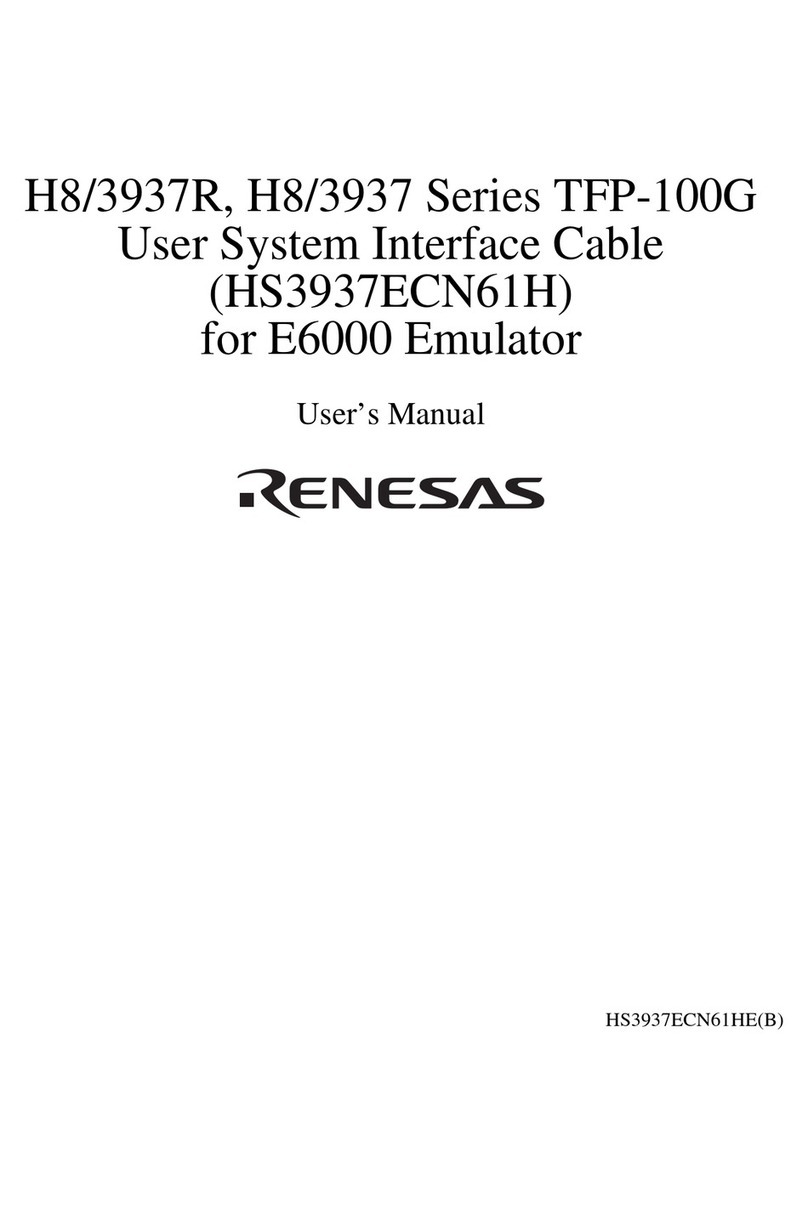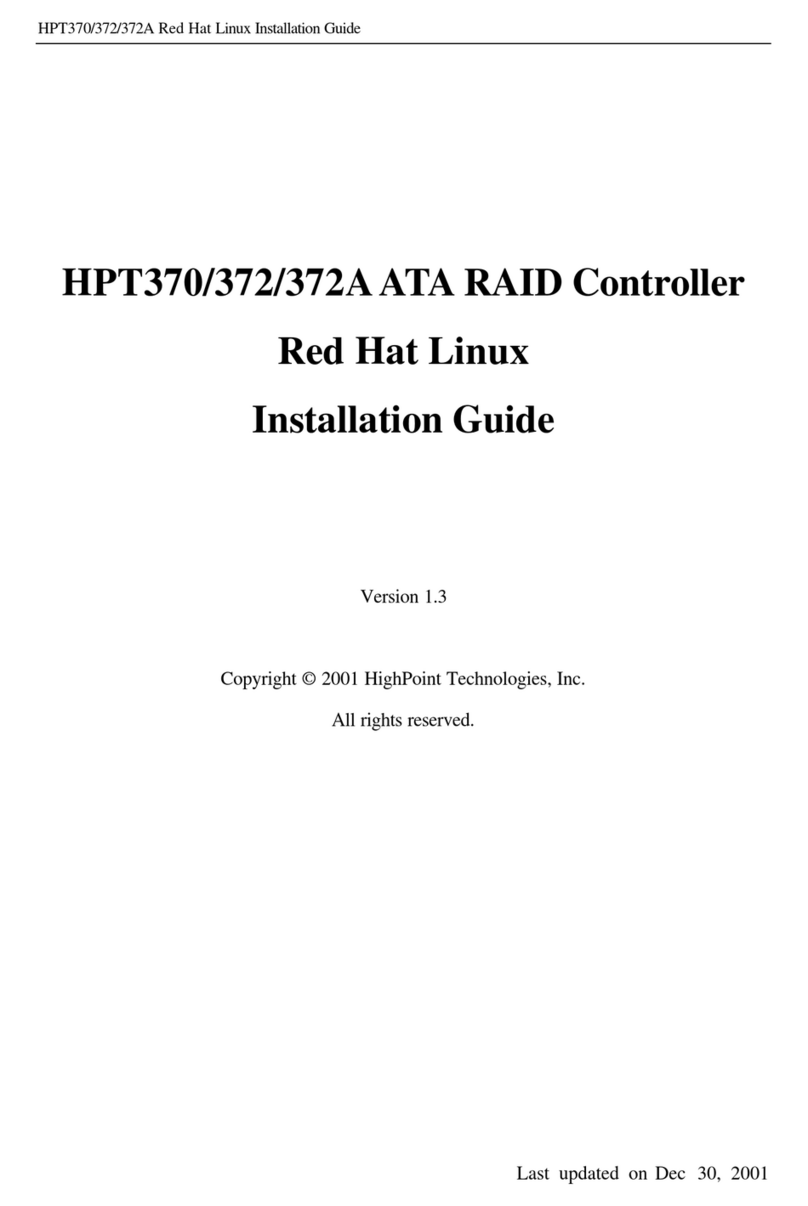LinMot B1100 Series User manual

For the following LinMot Drives
B1100 series
E1100 series
LinMot Drive Configuration over
Fieldbus Interfaces

LinMot Drive Configuration over Fieldbus
© 2016 NTI AG
This work is protected by copyright.
Under the copyright laws, this publication may not be reproduced or transmitted in any form, electronic or mechanical, including
photocopying, recording, microfilm, storing in an information retrieval system, not even for didactical use, or translating, in whole
or in part, without the prior written consent of NTI AG.
LinMot® is a registered trademark of NTI AG.
Note
The information in this documentation reflects the stage of development at the time of press and is therefore without obligation.
NTI AG reserves itself the right to make changes at any time and without notice to reflect further technical advance or product
improvement.
Document version 1.1/ mk/Ro, June 2016
age 2/25 arameterization of LinMot servo drives over fieldbus interfaces / 30.06.2016 NTI AG / LinMot

LinMot Drive Configuration over Fieldbus
Table of Content
1 INT ODUCTION..................................................................................................................4
2 FI MWA E PA AMETE S................................................................................................5
2.1 OVERVIEW....................................................................................................................... 5
2.2 UNIQUE ARAMETER ID AND RAW DATA VALUE....................................................................6
2.3 ROM AND RAM VALUE....................................................................................................6
2.4 DEFAULT VALUE...............................................................................................................8
2.5 32 BIT ACCESS FOR ANY ARAMETER TY E.........................................................................8
3 FI MWA E LAYE CONCEPT........................................................................................10
4 PA AMETE CONFIGU ATION COMPATIBILITY ULES............................................12
5 CU VES............................................................................................................................ 13
5.1 CURVE OBJECT..............................................................................................................14
5.2 CURVE INFO BLOCK........................................................................................................15
Data Offset....................................................................................................................15
Object Type...................................................................................................................15
Number of Setpoints.....................................................................................................15
Data Type Size............................................................................................................. 15
Name............................................................................................................................ 16
Curve D........................................................................................................................ 16
X-Length....................................................................................................................... 16
X/Y-Dimension UU D....................................................................................................16
Wizard nformation........................................................................................................ 16
5.3 CURVE DATA BLOCK.......................................................................................................17
5.4 ERASING ALL CURVES IN THE RAM OF THE DRIVE...............................................................17
5.5 U LOADING CURVES FROM THE DRIVE...............................................................................18
5.6 DOWNLOADING CURVES INTO THE RAM OF THE DRIVE........................................................19
6 COMMAND TABLE...........................................................................................................20
6.1 COMMAND TABLE ENTRY FORMAT.....................................................................................21
7 PVL DATA FO MAT.........................................................................................................22
8 CONTACT ADD ESSES..................................................................................................25
NTI AG arameterization of LinMot servo drives over fieldbus interfaces / 30.06.2016 age 3/25

LinMot Drive Configuration over Fieldbus
1 Introduction
Users of LinMot drives (series E1100 and B1100) can easily setup
their drive by using the LinMot-Talk software. Beside other
functionality (firmware download, monitoring, LC emulation, etc.),
the LinMot-Talk software is used for altering the firmware
configuration parameters, for creating and up- and downloading of
curve profiles.
Most of the LinMot drives are equipped with a fieldbus interface to the
superior control system ( LC, I C). This interface is used for
controlling the drive under normal operation conditions (read/write of
control and status word, sending motion commands, etc.).
If the LinMot drive uses a fieldbus connection for the communication
to the superior control system ( LC, I C), then the same fieldbus
interface can be used for configuration purposes as well. The
following fieldbus interfaces are supported: rofibus D , CANOpen,
DeviceNet, RS232 and RS485 (using LinRS protocol).
This document describes in general the access to the configuration
parameters and the curve data over fieldbus interfaces. Detailed
information about how data access is implemented in the respective
interfaces can be found in the corresponding interface user manuals.
NOTE: The series E1100 and B1100 differ in some functions from
each other. If nothing is indicated, the behavior is the same.
age 4/25 arameterization of LinMot servo drives over fieldbus interfaces / 30.06.2016 NTI AG / LinMot

LinMot Drive Configuration over Fieldbus
2 Firmware Parameters
2.1 Overview
The LinMot drive firmware has to be configured through its
parameters in order to meet the needs of the application where the
servo system has to be integrated. Typical examples of firmware
parameters that must be set during the commissioning process are
motor definition parameters, position control parameters, etc.
The easiest way to alter parameters is to use the LinMot-Talk
software tool. The software displays the parameters in a comfortable
tree structure. Most of the parameters are displayed as a scaled
value with the corresponding physical unit.
Figure 1: Firmware parameters listed in a tree structure
NTI AG arameterization of LinMot servo drives over fieldbus interfaces / 30.06.2016 age 5/25

LinMot Drive Configuration over Fieldbus
2.2 Unique Parameter ID and aw Data Value
The value of any parameter is stored as an integer value (raw data) in
the memory space of the drive. The parameter is identified through its
Unique arameter ID (U ID), which is a 16 Bit integer number.
Both, U ID and raw data value of any parameter can be displayed in
the LinMot-Talk parameter tree structure (press Show/Hide Details
button).
Figure 2: Detailed view for parameters
2.3 OM and AM Value
The value of any parameter is stored in the non-volatile memory area
of the LinMot drive (ROM value). During the boot-up process the
drive’s operating system creates a copy of the non-volatile memory
block to its RAM memory space. Thus, after the drive has powered
up, each parameter has two memory locations and values: one in the
ROM, the other in the RAM.
The firmware uses at run time exclusively the RAM values of the
parameters in its control tasks (fast data access). The drive’s
age 6/25 arameterization of LinMot servo drives over fieldbus interfaces / 30.06.2016 NTI AG / LinMot
Show/Hide
Details button
Unique
arameter ID
number
raw data value

LinMot Drive Configuration over Fieldbus
operating system and the fieldbus interfaces provide independent
access to ROM and RAM values.
When parameters are altered using the LinMot-Talk software, the
ROM and/or the RAM value are affected:
- When ‘live’ parameters are changed, then the LinMot-Talk software
writes to ROM and RAM memory.
- ‘Non-Live’ parameters are written only to ROM (and are copied to
RAM at next firmware start).
The LinMot-Talk software reads and displays the ROM values. It
reads the parameter values only once (during the login process). The
C software allows altering ‘non-live’ parameters only if the firmware
is stopped.
Over the fieldbus interface the RAM value of ‘non-live’ parameters
cannot be changed. Changing the ROM value is possible even when
the firmware is running (except for read-only parameters).
Changing the RAM value of a parameter immediately influences the
system behavior when the firmware is running (e.g. control
parameters of the position control loop).
Figure 3: Live arameters marked with a superscript 'L'
Changes to ROM values don’t affect the system behavior until the
next firmware startup (e.g. after a software reset initiated by the
superior control system or stop/start from the LinMot-Talk software).
NTI AG arameterization of LinMot servo drives over fieldbus interfaces / 30.06.2016 age 7/25
The RAM value of live
parameters (marked with a
superscript ‘L’) can be
altered at run time.

LinMot Drive Configuration over Fieldbus
2.4 Default Value
Beside the actual RAM and ROM value each parameter has its
default value. The default value is displayed in the detailed parameter
view of the LinMot-Talk software.
During firmware installation the ROM values are set to the default
values of the corresponding parameters.
E1100 drives provide resetting the parameters to their default values
over fieldbus interfaces. Resetting to default value is possible for
single parameters (via U ID) or for all parameters of any firmware
layer at once (see below).
NOTE: B1100 do not support this feature, because the default values
are not stored on the drive.
2.5 32 Bit Access for any Parameter Type
The whole configuration consists of parameters of different types (bit,
byte, 16bit integer, 32bit integer and string parameters). In order to
keep the interface as simple as possible any parameter can be
accessed as a 32bit integer value. The drive’s operating system will
filter out the relevant number of bits for each parameter.
Since string parameters can be longer than 4 characters (= 4 Bytes),
a single 32bit integer value is not sufficient to define a general string.
Therefore strings are handled in a special way:
-In the LinMot-Talk software to each string parameter one single
U ID is shown.
-Internally the string is split into parts (so called ‘stringlets’) of 4
characters (= 4 bytes = 32 bits).
-Each stringlet has its own U ID.
-For E1100 drives: The U ID of the first stringlet is the string U ID
plus 1, the U ID of the second stringlet is the string U ID plus 2
and so on.
-For B1100 drives: The U ID of the first stringlet is the string U ID
itself, the U ID of the second stringlet is the string U ID plus 1
and so on.
The following example shows the principle of converting strings to
raw data values.
age 8/25 arameterization of LinMot servo drives over fieldbus interfaces / 30.06.2016 NTI AG / LinMot

LinMot Drive Configuration over Fieldbus
Example:
Writing the string ‘X-Axis Left’ to the parameter ‘User Comment’:
Figure 4: String parameter example for E1100 (see U ID 03F2h)
Figure 5: String parameter example for B1100 (see UP D 7078h)
The following table shows how the stringlet UP Ds and the
corresponding 32bit integer values are determined:
Stringlet "X Ax" “is L” “eft”
arameter U ID
E1100
03F3h 03F4h 03F5h
arameter U ID
B1100
7078h 7079h 707Ah
Ordinal 1st Char: Ord(‘X’)=58h Ord(‘i’)=69h Ord(‘e’)=65h
Ordinal 2nd Char: Ord(‘ ‘)=20h Ord(‘s‘)=73h Ord(‘f‘)=66h
Ordinal 3rd Char: Ord(‘A’)=41h Ord(‘ ’)=20h Ord(‘t’)=74h
Ordinal 4th Char: Ord(‘x’)=78h Ord(‘L’)=4Ch 00h
arameter Value: 78412058h 4C207369h 00746665h
Table 1: The four firmware layers
NTI AG arameterization of LinMot servo drives over fieldbus interfaces / 30.06.2016 age 9/25

LinMot Drive Configuration over Fieldbus
3 Firmware Layer Concept
The firmware on the drive consists of up to four layers:
Layer Name Layer Functionality
1 Operating
System
- Resource Management
- Communication with LinMot-Talk
- Start/Stop of the other SW layers
- arameter / Variable Service
- Oscilloscope Service
- Message / Error Service
2 Motion
Control
Software
- Current Control Loop
- osition Control Loop
- Set Value Generation
- Monitoring
3 Interface
Software
- Communication to superior control system
(e.g. via rofibus, CANOpen, DeviceNet,
LinRS, etc.)
4 Application - Customized firmware extensions
Table 2: The four firmware layers
Each firmware part has its own parameters located in a separate
branch of the parameter tree.
Figure 6: arameter tree with branches for the different firmware
layers
age 10/25 arameterization of LinMot servo drives over fieldbus interfaces / 30.06.2016 NTI AG / LinMot

LinMot Drive Configuration over Fieldbus
On E1100 drives, each firmware layer has its own range of U IDs for
its parameters and variables.
Laye
r
Name U ID Range
1 Operating System 0000h…0EFFh
2 Motion Control SW 1000h…1EFFh
3 Interface Software 2000h…2EFFh
4 Application 3000h…3EFFh
Table 3: UP D value ranges for E1100 drives.
NOTE: On B1100 drives, the U IDs of the different software layers
are mixed and cannot be grouped.
The parameter definitions are stored in the drive. On E1100 drives
the U ID, RAM/ROM locations, default values, parameter type,
min/max values and access rights are stored. On B1100 drives the
U ID, RAM/ROM locations and the type are stored. The
corresponding definition files have been downloaded together with
the firmware when the firmware was installed on the drive.
Information about the currently installed parameter tree files can be
found in the operating system parameter tree branch.
Figure 7: arameter tree information
The parameter subtree (e.g. rofibus parameter tree V3.0 etc.) is
defined through its Tree ID, Main Version and SubVersion value. This
information can be captured by reading out the values of the
parameters with U ID according to the following table. These
parameters are used to perform compatibility tests before parameter
configurations are downloaded to drives (see below).
Layer Tree ID
U ID
E1100/B1100
Main Version
U ID
E1100/B1100
Sub Version
U ID
E1100/B1100
1 OS 0539h / 2CA1h 0532h / 2C96h 0533h / 2C97h
2 MC SW 0561h / 2FA1h 055Ah / 2F96h 055Bh / 2F97h
3 Interface SW 0589h / 2EA1h 0582h / 2E96h 0583h / 2E97h
4 Application 05B1h / 2DA1 05AAh / 2D96 05ABh / 2D97h
Table 4: UP D value ranges for E1100 drives.
NTI AG arameterization of LinMot servo drives over fieldbus interfaces / 30.06.2016 age 11/25

LinMot Drive Configuration over Fieldbus
4 Parameter Configuration Compatibility ules
The current parameter configuration can be stored into a VL file.
This text file contains the parameter U ID and value in an easy to
interpret list. This parameter list can easily be stored in a superior
machine drive ( LC, I C) and downloaded to any drive of the same
type if necessary.
Besides the parameters raw data the VL file contains additional
information about the system on which the VL file was created.
Before complete parameter configurations are downloaded from the
superior machine control system to the LinMot drive, it is
recommended to perform some compatibility checks. With these
checks it can be ensured, that the configuration stored in the superior
control system (source file) is fully compatible with the firmware
installed drive (target system).
The following rules must be considered for each firmware layer:
Check Value Rule
Tree ID Tree ID of the source file and target system
must be the same (e.g. it is not possible to
download a DeviceNet setup onto a drive with
rofibus interface firmware installed).
Tree Main Version The source file parameter tree must have the
same Main Version as the tree installed on the
target system.
Tree Sub Version The Sub Version of the source must be the
same or smaller than the corresponding value
of the target system (backward compatibility
within main version).
Table 5: UP D value ranges for E1100 drives.
age 12/25 arameterization of LinMot servo drives over fieldbus interfaces / 30.06.2016 NTI AG / LinMot

LinMot Drive Configuration over Fieldbus
5 Curves
NOTE: This chapter is only valid for E1100 drives. B1100 drives
do NOT support curve downloading over the fieldbus.
The E1100 drives can store up to 100 curves, which can be
generated and downloaded by the LinMot-Talk software. The curves
are identified by their ID (1..100).
Figure 8: Curves within LinMot-Talk
The curves, which can be accessed by the motion control firmware
through corresponding motion commands, are located in the RAM
memory space of the drive. They can be permanently stored into a
flash memory block as well. At boot time the operating system copies
the curve data from the flash memory to the RAM memory block.
The curve profiles, which are generated and downloaded using the
LinMot-Talk software, are always stored to RAM and flash memory
(permanently saved).
It is also possible to download curves to the drive over the fieldbus.
Then it is necessary to have the curve objects stored in the superior
machine controller. There are three ways to bring the profiles there:
1. The curves are created and downloaded to a drive with LinMot-
Talk. Then the curve objects can be uploaded from the drive over the
fieldbus interface (using the curve service).
2. The curves are created and then exported to a raw data file ( VL
file) using the LinMot-Talk software. Then the VL file can be loaded
to the main controller.
3. The curve object is fully generated by the main machine controller
without using the LinMot-Talk curve tool.
NTI AG arameterization of LinMot servo drives over fieldbus interfaces / 30.06.2016 age 13/25
x dimension
(typically time)
y dimension
(typically position)

LinMot Drive Configuration over Fieldbus
5.1 Curve Object
Each curve object consists of a curve info block (header) and a curve
data block (setpoints). The curve service provides commands for
reading/writing these blocks. For further details how the curve service
is implemented in the various fieldbus interfaces please consult the
corresponding interface manuals.
Curve Info Block
Byte Off Type Name
0..1 UInt16 Data offset
2..3 UInt16 Object type
4..5 UInt16 Number of setpoints
6..7 UInt16 Data Type size
8..29 String Name
30..31 UInt16 Curve ID
32..35 UInt32 x-Length
36..37 UInt16 XDimUUID
38..39 UInt16 YDimUUID
40..41 UInt16 Wizard Type
42..45 UInt32 Wizard ar 1
46..49 UInt32 Wizard ar 2
50..53 UInt32 Wizard ar 3
54..57 UInt32 Wizard ar 4
58..61 UInt32 Wizard ar 5
62..65 UInt32 Wizard ar 6
66..69 UInt32 Wizard ar 7
Curve Data Block
0..xxx Curve Setpoints
Table 6: Curve Object: nfo Block and Data Block
age 14/25 arameterization of LinMot servo drives over fieldbus interfaces / 30.06.2016 NTI AG / LinMot

LinMot Drive Configuration over Fieldbus
5.2 Curve Info Block
Data Offset
The Data Offset contains the info block size information. The software
expects the info block to consist of 70 bytes. So the first word of the
info block must have the value 70 (= 46h).
Object Type
The Object Type word consists of four nibbles (1 nibble = 4 bits):
-lowest nibble: Object Version (must be 3)
-lower middle nibble: Type of Object (Curve = 0h)
-higher middle nibble: X dimension Code
-highest nibble: Y dimension Code
Curve Info Block: Object Type
Byte Name Bit
7
Bit
6
Bit
5
Bit
4
Bit
3
Bit
2
Bit
1
Bit 0
0 Type & Version Type of Object: 0h
(=Curve)
Version: 3h (=SW-
Version 3.x)
1 X & Y
dimension codes
Y dimension code:
0: osition
1: Velocity
2: Current
3: Encoder os
(Increments)
4: Encoder Speed
5: MicroSteps
X dimension code:
0: Time
1: Encoder os
(Increments)
2: osition
Table 7 Curve nfo Block: Object Type
According to the definitions above the Object Type has the following
value:
-osition vs. Time curve: 0003h
-Cam profiles ( os vs. Enc. os.): 0103h
Other object types are not supported yet.
Number of Setpoints
The number of setpoints of the profile is given as 16bit value. The
minimal number of setpoints is 2.
Data Type Size
This value defines the size of one setpoint. osition values are
defined in 32bit format (32bit = 4 bytes).
NTI AG arameterization of LinMot servo drives over fieldbus interfaces / 30.06.2016 age 15/25

LinMot Drive Configuration over Fieldbus
Name
In order to make identification easier, a descriptive name can be
defined (e.g. ‘Fast Move Out’ or ‘Retraction’). 22 bytes are reserved
for the name string. The string is terminated with 00h.
If the profile is machine generated ( LC- rogram, etc.), the name
space will be typically filled with 00h.
Curve ID
The Curve D must be unique. Allowed values are : 1..100
(0001h..0064h).
X-Length
The X-Length defines the base length of the curve profile.
-osition vs. Time Curve : Time [10us]
-Cam profiles ( os vs. Enc. os.) : Encoder os [Increments]
X/Y-Dimension UUID
The following Unique Unit IDs (UUIDs) are supported:
Unit Definition
UUID Unit Scaling Description
0005h 0.1 um (=1*10-7m) Standard Linear osition Unit
001Ah 0.01 ms (=1*10-5s) Standard Curve Time Unit
001Bh 1 Increment Standard Encoder osition Unit
Table 8: Unit Definitions
According to the table above the following values are correct:
osition vs. Time Curves : XDimUUID = 001Ah
YDimUUID = 0005h
Cam rofiles : XDimUUID = 001Bh
YDimUUID = 0005h
Wizard Information
The wizard information (wizard type & wizard parameters) is used
only by the LinMot-Talk software. All those bytes should be set to 00h
for curves which are not generated with the LinMot-Talk curve tool.
age 16/25 arameterization of LinMot servo drives over fieldbus interfaces / 30.06.2016 NTI AG / LinMot

LinMot Drive Configuration over Fieldbus
5.3 Curve Data Block
The curve data block contains the setpoints (Y-dimension). The size
of the block is: No Of Setpoints * Data Type Size
The setpoints are equally spaced over the x-length. The x-dimension
equidistance is: x-Length / (No Of Setpoints – 1).
5.4 Erasing all curves in the AM of the Drive
All curves in the RAM of the drive can be deleted by the following
command:
-Curve Service: Delete all Curves (RAM)
NTI AG arameterization of LinMot servo drives over fieldbus interfaces / 30.06.2016 age 17/25

LinMot Drive Configuration over Fieldbus
5.5 Uploading Curves from the Drive
To read a curve from the drive using the fieldbus interface, the
following commands have to be used:
-Curve Service: Get Curve
-Curve Service: Get Curve Info Block
-Curve Service: Get Curve Data
The curve service commands are described in the corresponding
interface manuals.
Reading a curve is according the following scheme:
Begin Read Curve x
G e t C u rv e :
-> x (c u rv e N u m b e r)
< - I (In fo B lo c k s iz e )
< - D (D a ta B lo c k s iz e )
NO
YES
NO
YES
OK?
G e t C u rv e In fo B lo c k :
-> x (c u rv e N u m b e r)
< - (In fo B lo ck D a ta [x ..y ])
OK? NO
YES
All Info Block Data read?
G e t C u rv e D a ta B lo c k :
-> x (c u rv e N u m b e r)
< - (D a ta B lo c k D a ta [x ..y ])
OK? NO
All Data Block Data read?
YES
Finished Read Curve x
YES
Figure 9: Flowchart Read Curve
age 18/25 arameterization of LinMot servo drives over fieldbus interfaces / 30.06.2016 NTI AG / LinMot

LinMot Drive Configuration over Fieldbus
5.6 Downloading Curves into the AM of the Drive
To write a curve into the RAM of the drive, the following commands
have to be used:
-Curve Service: Add Curve
-Curve Service: Add Curve Info Block
-Curve Service: Add Curve Data
The writing of a curve is always according to the following scheme:
Begin Add Curve x
Add Curve:
-> x (curve Number)
-> I (Info Block size)
-> D (Data Block size)
NO
YES
NO
YES
OK?
Add Curve Info Block:
-> x (curve Number)
-> (Info Block Data [x..y])
OK? NO
YES
All Info Block Data written?
Add Curve Data Block:
-> x (curve Number)
-> (Data Block Data [x..y])
OK? NO
All Data Block Data written?
YES
Finished Add Curve x
YES
Figure 10: Flowchart Add Curve
NTI AG arameterization of LinMot servo drives over fieldbus interfaces / 30.06.2016 age 19/25

LinMot Drive Configuration over Fieldbus
6 Command Table
NOTE: This chapter is only valid for E1100 drives. B1100 drives
do NOT support command tables.
For programming simple sequences with decisions the LinMot drive
supports the command table (CT) programming utility. Up to 255 CT
entries can be programmed. The entries can be arranged in
sequences and some branch possibilities are supported.
Figure 11: Command Table within LinMot-Talk
The CT entries can be accessed by the motion control firmware
through corresponding motion commands or through digital IOs. The
firmware uses the table data that is located in the RAM memory
space of the drive. The CT can be stored permanently into the flash
memory as well. At boot time the operating system copies the entire
CT from the flash memory to the RAM.
If the CT entries are generated and downloaded using the LinMot-
Talk 4 software, they are always stored into RAM and flash memory
(permanently saved).
It is also possible to download or modify CT entries in the drive over a
fieldbus. Then it is necessary to have the CT entry data stored in the
superior machine controller. There are three ways to bring the entry
data to the LinMot drive:
1. The CT entries are created and downloaded to a drive by using
LinMot-Talk. Afterwards the CT entry data can be uploaded from the
drive over the fieldbus interface (using the CT service).
2. The CT entries are created and then exported to a raw data file
( VL file) using the LinMot-Talk software. This generated file can be
loaded to the main controller.
3. The CT entry data is fully generated by the main machine controller
without using the LinMot-Talk command table editor.
age 20/25 arameterization of LinMot servo drives over fieldbus interfaces / 30.06.2016 NTI AG / LinMot
Other manuals for B1100 Series
1
This manual suits for next models
1
Table of contents
Other LinMot Computer Hardware manuals
